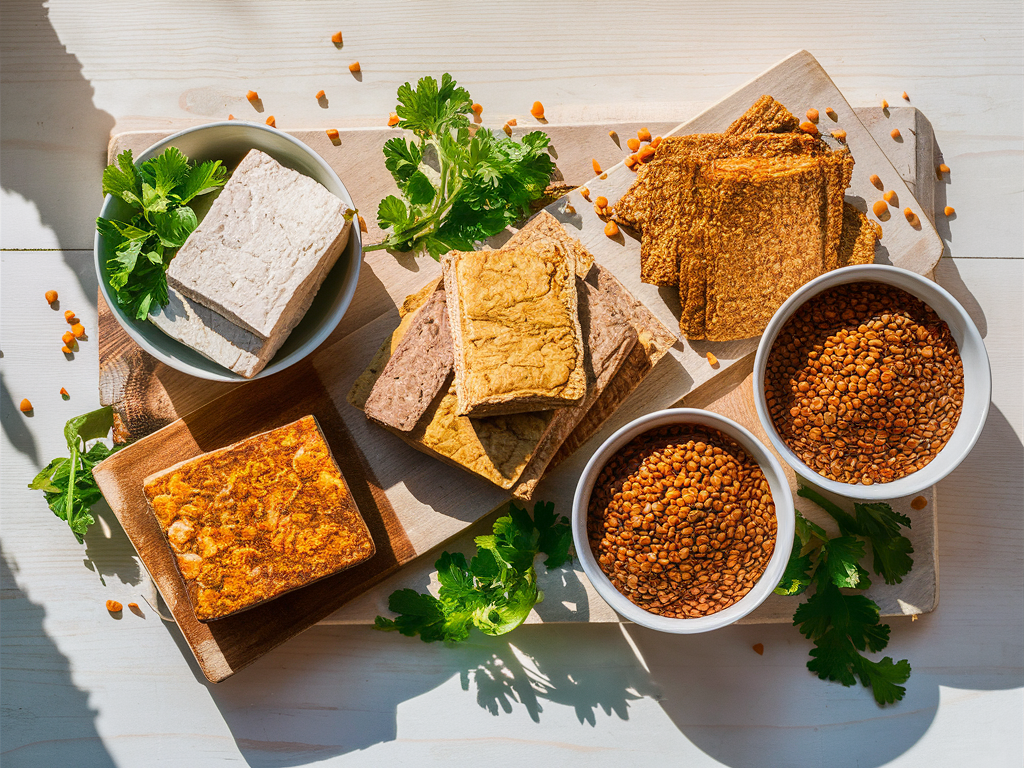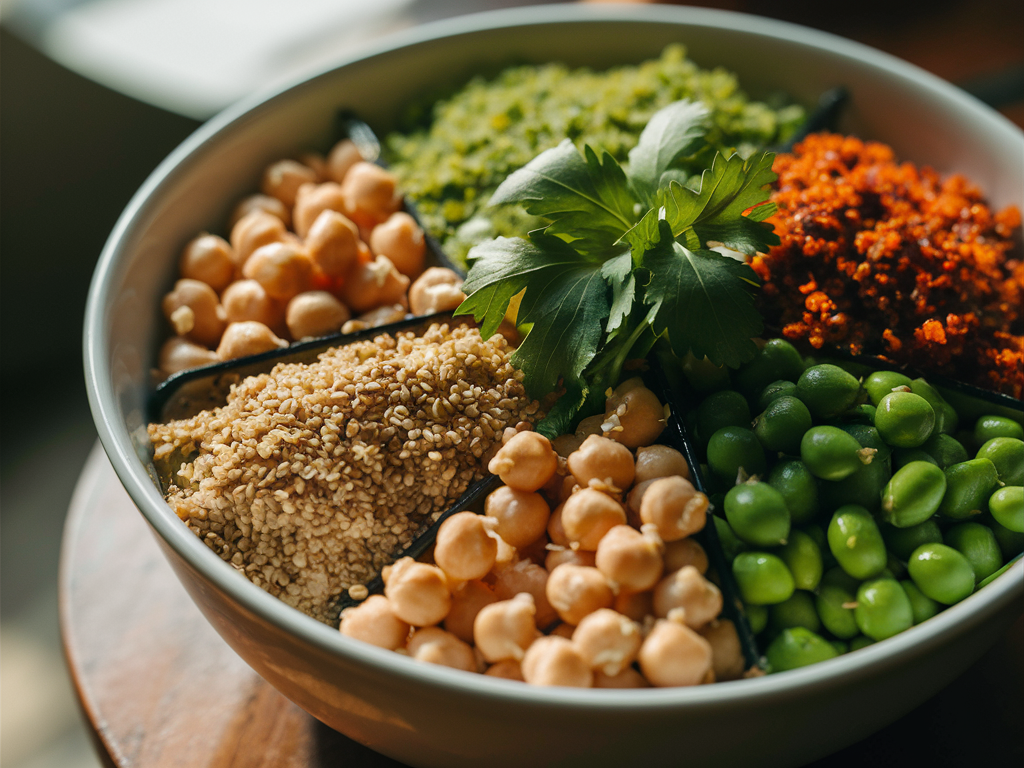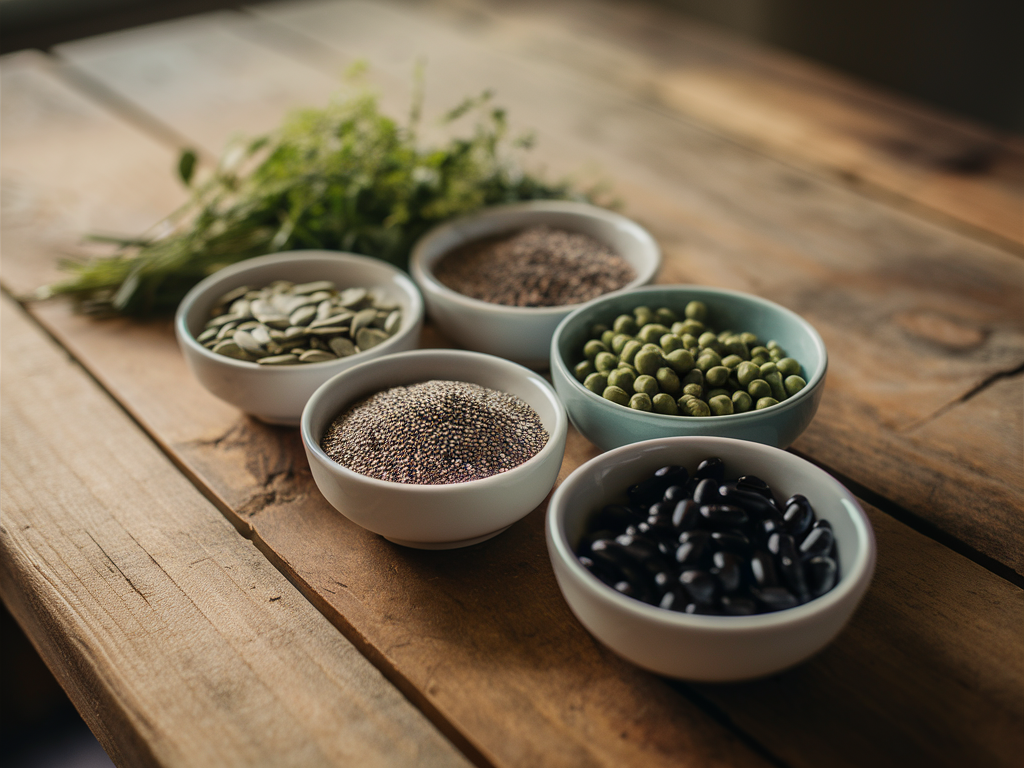Concerned about getting enough protein on a plant-based diet? This common misconception keeps many people from exploring veganism, but the truth is that plants can provide all the protein your body needs. In this comprehensive guide, we’ll explore 15 powerful plant-based protein sources that not only meet your nutritional requirements but also offer additional health benefits conventional animal proteins can’t match.
Protein is essential for building muscle, supporting immune function, and maintaining virtually every cellular process in the body. While animal products are traditionally considered the go-to protein sources, plant-based options are increasingly recognized for their ability to fulfill protein requirements while offering additional benefits like fiber, antioxidants, and reduced environmental impact.
Many newcomers to plant-based eating worry about protein deficiency, but this concern is largely unfounded when consuming a varied, nutrient-dense vegan diet. Plant proteins can provide all essential amino acids when eaten in sufficient quantities and combinations throughout the day.
This curated list of high-protein vegan foods will help you diversify your diet while ensuring optimal protein intake. Whether you’re a committed vegan, vegetarian, or simply looking to incorporate more plant-based meals into your routine, these foods deserve a place in your kitchen.
1. Tofu
Tofu stands as a cornerstone of plant-based protein, delivering approximately 8-10 grams per 3-ounce serving. This soy-based protein chameleon absorbs flavors brilliantly while providing a complete amino acid profile.
Beyond protein, tofu offers calcium, iron, and manganese while containing minimal saturated fat. Its versatility makes it suitable for everything from breakfast scrambles to dinner stir-fries.
Quick recipe ideas include crispy air-fried tofu cubes, silken tofu chocolate mousse, and marinated tofu steaks. The texture variations—from silken to extra-firm—create endless culinary possibilities for every meal.
2. Tempeh
Tempeh elevates soy protein through fermentation, providing an impressive 15-16 grams of protein per 3-ounce serving. Unlike tofu, tempeh maintains a distinctive nutty flavor and hearty texture that many find satisfying as a meat alternative.
The fermentation process creates beneficial probiotics while reducing phytic acid, potentially enhancing nutrient absorption. Tempeh’s firm, chewy texture holds up exceptionally well in sandwiches, stir-fries, and baking applications.
For best results, steam tempeh before marinating to remove any bitterness and enhance flavor absorption. Try crumbling it into chili, slicing for sandwiches, or cubing for protein-packed salad toppers.
3. Seitan (Vital Wheat Gluten)
For those without gluten sensitivities, seitan provides the highest protein concentration on our list—about 21 grams per 3-ounce serving. Made from wheat gluten, seitan closely mimics meat’s texture, making it particularly appealing to recent plant-based converts.
Seitan is produced by washing wheat flour to remove starch, leaving behind primarily protein. Its chewy, dense texture absorbs flavors exceptionally well, making it perfect for replicating traditional meat dishes.
Commercial seitan products abound, but homemade versions allow complete control over flavoring. It excels in applications like vegan “chicken” nuggets, stir-fries, and sandwiches where a substantial protein element is desired.

4. Lentils
These nutritional powerhouses deliver approximately 18 grams of protein per cooked cup while providing substantial dietary fiber—a combination that supports sustained energy and digestive health.
Different varieties offer unique applications: red lentils break down quickly for soups and curry bases; green and brown varieties hold shape for salads and side dishes; while black beluga lentils maintain their form for elegant preparations.
Beyond protein, lentils provide iron, zinc, folate, and potassium. They cook relatively quickly compared to other legumes (typically 15-30 minutes) and don’t require pre-soaking, making them ideal for weeknight meals.
5. Chickpeas
With approximately 15 grams of protein per cooked cup, chickpeas (garbanzo beans) offer incredible versatility across cuisines. Their mild, nutty flavor works in everything from traditional hummus to roasted snacks and hearty curries.
Nutritionally, chickpeas provide substantial amounts of fiber, iron, phosphorus, and B vitamins. Their unique composition helps regulate blood sugar while supporting digestive health.
For convenience, keep both dried and canned chickpeas on hand. Dried varieties offer economic value and texture control, while canned options provide immediate meal solutions. Try them roasted with spices for a protein-rich snack, blended into creamy dressings, or as the central protein in Buddha bowls.
6. Quinoa
Often called a “supergrain” (though technically a seed), quinoa contains about 8 grams of protein per cooked cup. Unlike most plant foods, quinoa provides all nine essential amino acids in balanced proportions, earning its status as a complete protein.
Beyond protein, quinoa delivers manganese, phosphorus, magnesium, and folate. Its versatility spans breakfast porridges to dinner sides, with a pleasant texture and mild, slightly nutty flavor profile.
Cook quinoa in a ratio of 1:2 (quinoa to liquid) for about 15 minutes, then fluff with a fork after resting. For enhanced flavor, toast dry quinoa briefly before adding cooking liquid, and consider using vegetable broth instead of water.
7. Edamame
These young soybeans deliver approximately 17 grams of protein per cup (shelled) and provide an exceptionally balanced amino acid profile. Unlike many protein sources, edamame offers a refreshing, slightly sweet flavor with a satisfying texture.
Nutritionally, edamame provides fiber, iron, calcium, and vitamin K. They’re also one of the few plant sources containing significant amounts of omega-3 fatty acids.
Preparation couldn’t be simpler—steam or boil for 3-5 minutes, optionally season with sea salt, and enjoy. Incorporate edamame into grain bowls, stir-fries, or simply enjoy as a protein-rich snack.
8. Nutritional Yeast
This deactivated yeast packs an impressive 8-10 grams of protein per quarter-cup serving, while delivering a distinctive cheesy, nutty flavor that enhances countless vegan dishes.
Most varieties are fortified with vitamin B12—a nutrient primarily found in animal products—making nutritional yeast particularly valuable for vegans. It also contains zinc, selenium, and complete protein.
Sprinkle nutritional yeast on popcorn, blend into vegan cheese sauces, add to tofu scrambles, or incorporate into homemade plant-based parmesan alternatives. Its flavor compounds enhance umami elements in virtually any savory dish.

9. Hemp Seeds
These tiny nutritional giants contain about 10 grams of protein per 3-tablespoon serving. Unlike many seeds, hemp provides all essential amino acids, qualifying it as a complete protein source.
Hemp seeds offer an ideal balance of omega-3 and omega-6 fatty acids, along with vitamin E, phosphorus, potassium, and magnesium. Their mild, slightly nutty flavor complements rather than dominates other ingredients.
No cooking required—simply sprinkle hemp seeds on salads, blend into smoothies, stir into oatmeal, or incorporate into homemade energy bars. Their subtle flavor and exceptional nutrition make them one of the easiest protein boosters to incorporate into daily eating.
10. Chia Seeds
With approximately 5 grams of protein per 2-tablespoon serving, chia seeds may not top the protein density list, but their exceptional nutrient profile earns them a place among vegan protein stars.
Chia seeds contain more omega-3 fatty acids than salmon (by weight) and provide extraordinary amounts of fiber—approximately 10 grams per serving—supporting digestive health and satiety.
Beyond the common pudding applications, try chia as an egg substitute in baking (1 tablespoon chia + 3 tablespoons water equals one egg), blend into smoothies, or use as a crunchy topping for avocado toast, yogurt alternatives, and salads.
11. Spirulina
This blue-green algae contains approximately 4 grams of protein per tablespoon—an extraordinary concentration for a whole food supplement. Even more impressive, spirulina’s protein is highly bioavailable, with estimates suggesting 85-95% digestibility.
Nutritionally, spirulina provides exceptional amounts of beta-carotene, iron, manganese, and chromium. It’s also one of the few plant sources of active vitamin B12, though absorption rates vary.
The distinctive taste can be challenging for newcomers, so start with small amounts blended into smoothies with strong flavors like banana and cacao. Alternatively, spirulina capsules provide the nutritional benefits without the taste factor.
12. Black Beans
These kitchen staples provide approximately 15 grams of protein per cooked cup while delivering substantial fiber—about 15 grams per serving—supporting digestive health and sustained energy.
Black beans contain anthocyanins (the compounds that create their distinctive color), offering antioxidant benefits alongside their impressive macro and micronutrient profile.
Their versatility spans cuisines—from Latin American classics like black bean soup and refried beans to contemporary applications in veggie burgers and brownies (yes, brownies!). Their affordability makes them particularly valuable for budget-conscious plant-based eating.
13. Peanut Butter
This beloved spread contains approximately 8 grams of protein per 2-tablespoon serving, along with healthy monounsaturated fats that support heart health and provide sustained energy.
Beyond sandwiches, peanut butter enhances overnight oats, smoothies, sauces, and baking applications. Its compatibility with both sweet and savory profiles makes it exceptionally versatile.
When selecting peanut butter, opt for varieties containing only peanuts and perhaps salt, avoiding unnecessary additives like hydrogenated oils and sugar. Natural separation is a positive sign, indicating minimal processing.
14. Green Peas
Often overlooked as a protein source, green peas provide about 8 grams per cooked cup. Their sweet flavor and bright color make them a welcome addition to many dishes.
Nutritionally, peas offer vitamin K, manganese, fiber, and several B vitamins. Their natural sweetness can enhance dishes without added sugars.
Fresh peas offer superior flavor during their brief season, but frozen varieties maintain excellent nutritional value year-round. Beyond side dishes, try peas in pesto, hummus variations, and simple mashed preparations with herbs.

15. Pumpkin Seeds
Also known as pepitas, pumpkin seeds contain about 9 grams of protein per quarter-cup serving. Their distinctive flavor works well in both sweet and savory applications.
Pumpkin seeds are exceptional sources of magnesium, zinc, and plant-based omega-3 fatty acids. Their zinc content makes them particularly valuable for immune support.
For enhanced flavor, toast raw pumpkin seeds lightly before consuming. They make excellent salad toppers, yogurt additions, or standalone snacks. Try blending them into pesto or incorporating them into homemade granola and energy bars.
Conclusion
The protein content of these plant foods ranges from 5-21 grams per serving, demonstrating that a well-planned vegan diet can easily meet protein requirements. The key lies in variety and balance—consuming different protein sources throughout the day ensures you receive all essential amino acids.
Rather than focusing on “complete proteins” at every meal, nutritionists now recommend consuming a variety of plant proteins throughout the day. Your body efficiently pools amino acids to create the proteins it needs.
By incorporating these fifteen protein-rich plant foods into your regular meal rotation, you’ll not only meet your protein needs but also benefit from the abundant fiber, phytonutrients, and antioxidants missing from many animal-based protein sources.
Bonus: Sample Meal Plan
Breakfast options: Tofu scramble with nutritional yeast and black beans; overnight oats with chia seeds, hemp seeds, and peanut butter; or a protein-packed smoothie with spirulina, hemp seeds, and peanut butter.
Lunch combinations: Quinoa bowl with roasted chickpeas, edamame, and pumpkin seeds; tempeh sandwich with avocado; or lentil soup with a side of toasted pumpkin seeds.
Dinner ideas: Chickpea and vegetable curry with quinoa; seitan stir-fry with edamame and black beans; or lentil loaf with mashed green peas and roasted vegetables.
Snack options: Apple slices with peanut butter; roasted chickpeas; edamame with sea salt; or green smoothies with hemp seeds and spirulina.
With these protein-rich foods and meal ideas, you’ll quickly discover that meeting protein needs on a vegan diet isn’t just possible—it’s deliciously achievable.

